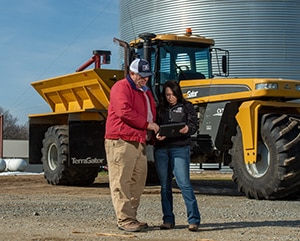Benjamin Ellis farms 1,000 acres of corn, 750 acres of soybeans and 750 acres of wheat/double-crop soybeans near Champlain, Virginia. The fourth-generation farm is on the banks of the Rappahannock River, part of the highly regulated Chesapeake Bay watershed. 4R nutrient stewardship management practices guide Ellis and Erin Hardin, precision ag coordinator with Southern States Cooperative (SSC), as they make annual plans for nutrient applications. Doing so ensures the farm complies with the Virginia Nutrient Management Rule.
Ellis started incorporating the 4Rs 11 to 12 years ago as he dealt with soil acidity challenges. He credits SSC’s Chris Conway-Haishi for getting him started in the Southern States Precision Ag Program before Hardin joined the coop.
“Once we got the ball rolling with precision ag and got the pH levels corrected in some fields, it had a positive rollover effect on the rest of the farm,” Ellis says. “Once I saw the benefits of getting pH levels corrected, the precision fertilizer applications and related 4R management practices were naturals. Last year was probably the most intensively I’ve incorporated the practices. We did variable-rate planting, variable-rate nitrogen, variable-rate fertilizing and variable rate of lime on about 90 percent of the farm.”
Ellis isn’t stopping with nutrient improvements. Virginia Tech trials are underway to determine what varieties and hybrids are best suited for the area, optimal soybean population and what starter fertilizer is best on corn.
Ellis and Hardin spend a lot of time reviewing soil test results, analyzing the data and understanding the scenarios that go on in the different fields.
“After every harvest, we get the data from the machines to combine and overlay with soil maps and really critique the results to find out what and where we need to change,” Ellis says.
Improving soil health is a key goal the two share equally. “We’re always working to build up soil health and that relates to variable-rate nitrogen,” Hardin says. “We back up our variable-rate nitrogen application with satellite imagery and scouting before we even apply it. We variable-rated every acre of corn nitrogen last year.
“The zones are made from the same zones we variable-rate the seed from, so we variable rate the nitrogen and match it to the population, as well as what is needed in the ground so that we’re always building up the soil health,” Hardin adds.
Ellis’ records prove the 4R principles pay off. Nitrogen use efficiency has gone from 1.3 lb/bu to 0.9 lb/bu. Split nitrogen application yielded 207 bu/ac corn yield. Using variable-rate dry fertilizer saved him $22/ac in 2019 and $31/ac in 2020. He reduced the tonnage of lime applied by 50 percent. He’s also observed a 7 bu/ac yield increase from 2019 to 2020 in one of his highly challenged wheat fields.
“The best part of the 4R program is that we only put fertilizer and nitrogen where they need to be,” Ellis says. This benefits him, his neighbors and the Chesapeake Bay, he says.
Best Practice Management
- Nitrogen stabilizer for dry and liquid fertilizers
- Nitrification inhibitors
- Phosphate efficiency enhancement additives
- Grid soil sampling
- Split application for nutrients
